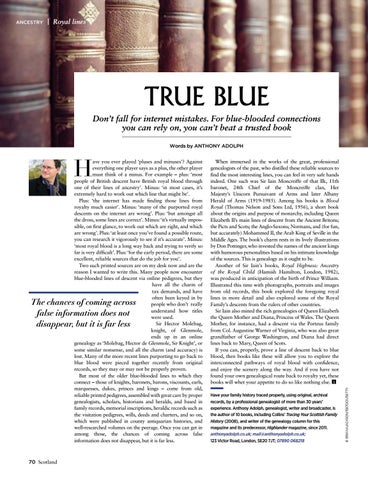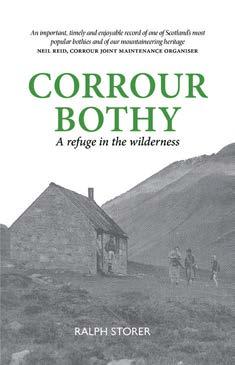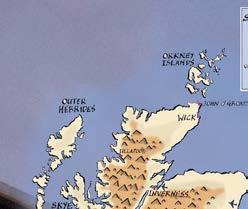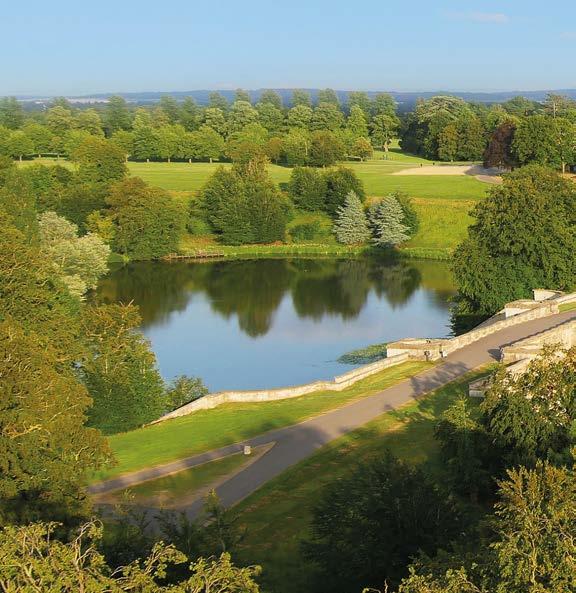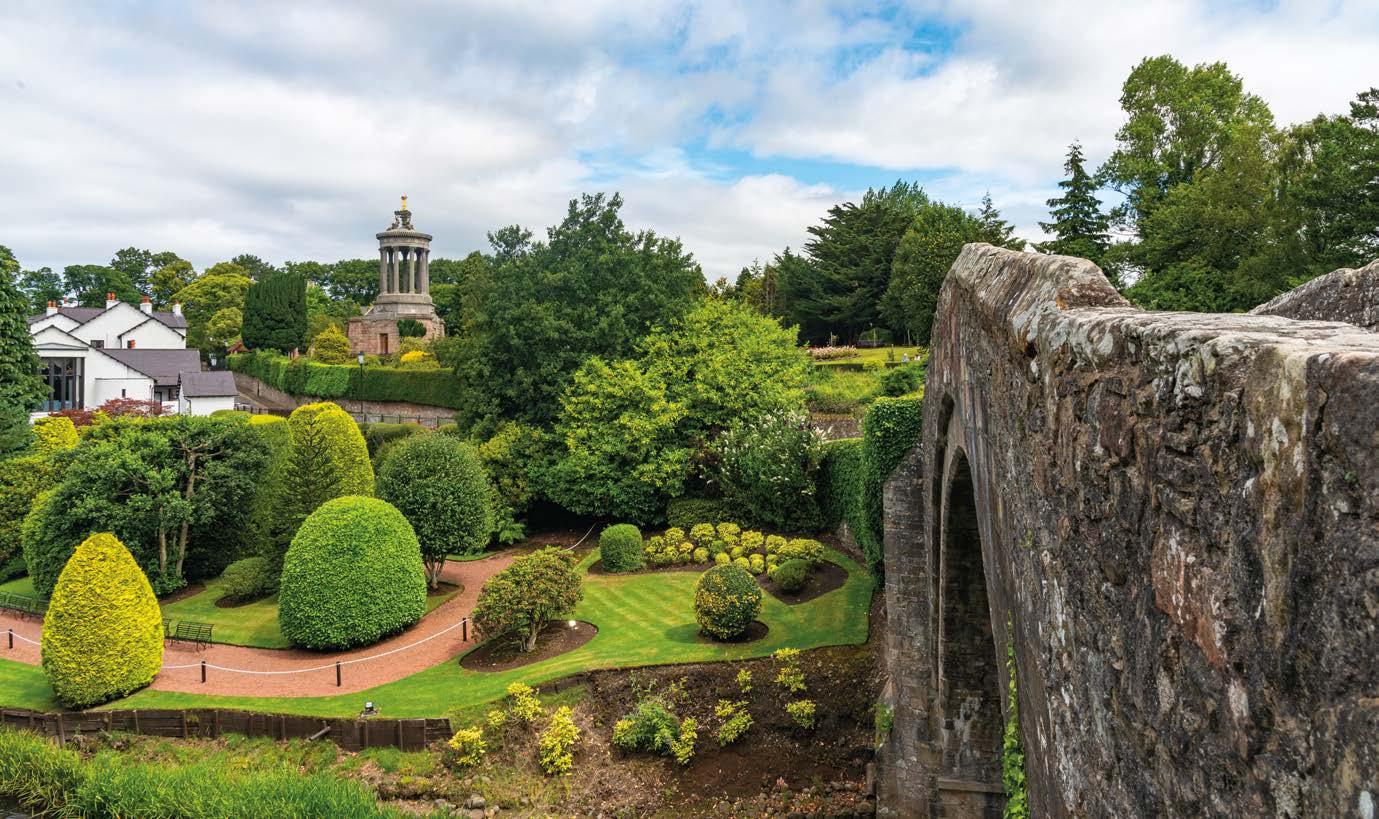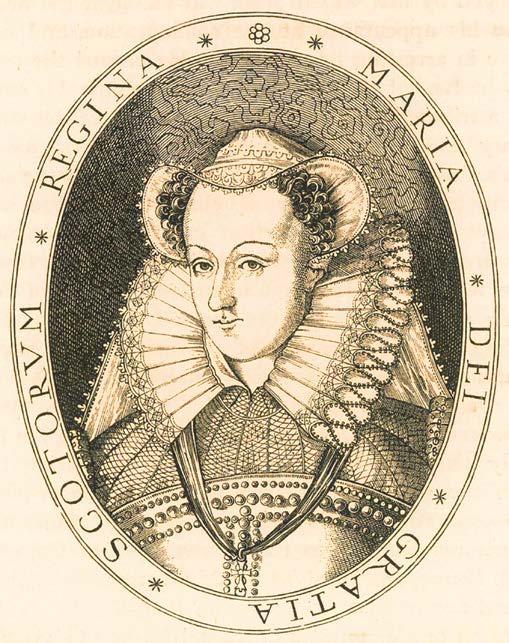ancestry
| Royal lines
TRUE BLUE Don’t fall for internet mistakes. For blue-blooded connections you can rely on, you can’t beat a trusted book Words by ANTHONY ADOLPH
The chances of coming across false information does not disappear, but it is far less
70 Scotland
When immersed in the works of the great, professional genealogists of the past, who distilled these reliable sources to find the most interesting lines, you can feel in very safe hands indeed. One such was Sir Iain Moncreiffe of that Ilk, 11th baronet, 24th Chief of the Moncreiffe clan, Her Majesty’s Unicorn Pursuivant of Arms and later Albany Herald of Arms (1919-1985). Among his books is Blood Royal (Thomas Nelson and Sons Ltd, 1956), a short book about the origins and purpose of monarchy, including Queen Elizabeth II’s main lines of descent from the Ancient Britons; the Picts and Scots; the Anglo-Saxons; Normans, and (for fun, but accurately) Mohammed II, the Arab King of Seville in the Middle Ages. The book’s charm rests in its lively illustrations by Don Pottinger, who invested the names of the ancient kings with humorous personalities based on his intimate knowledge of the sources. This is genealogy as it ought to be. Another of Sir Iain’s books, Royal Highness: Ancestry of the Royal Child (Hamish Hamilton, London, 1982), was produced in anticipation of the birth of Prince William. Illustrated this time with photographs, portraits and images from old records, this book explored the foregoing royal lines in more detail and also explored some of the Royal Family’s descents from the rulers of other countries. Sir Iain also mined the rich genealogies of Queen Elizabeth the Queen Mother and Diana, Princess of Wales. The Queen Mother, for instance, had a descent via the Porteus family from Col. Augustine Warner of Virginia, who was also great grandfather of George Washington, and Diana had direct lines back to Mary, Queen of Scots. If you can, properly, prove a line of descent back to blue blood, then books like these will allow you to explore the interconnected pathways of royal blood with confidence, and enjoy the scenery along the way. And if you have not found your own genealogical route back to royalty yet, these books will whet your appetite to do so like nothing else. S Have your family history traced properly, using original, archival records, by a professional genealogist of more than 30 years’ experience. Anthony Adolph, genealogist, writer and broadcaster, is the author of 10 books, including Collins’ Tracing Your Scottish Family History (2008), and writer of the genealogy column for this magazine and its predecessor, Highlander magazine, since 2011. anthonyadolph.co.uk; mail@anthonyadolph.co.uk; 123 Victor Road, London, SE20 7JT; 07890 068218
© BRIANAJACKSON/ISSTOCK/GETTY
H
ave you ever played ‘pluses and minuses’? Against everything one player says as a plus, the other player must think of a minus. For example – plus: ‘most people of British descent have British royal blood through one of their lines of ancestry’. Minus: ‘in most cases, it’s extremely hard to work out which line that might be’. Plus: ‘the internet has made finding those lines from royalty much easier’. Minus: ‘many of the purported royal descents on the internet are wrong’. Plus: ‘but amongst all the dross, some lines are correct’. Minus: ‘it’s virtually impossible, on first glance, to work out which are right, and which are wrong’. Plus: ‘at least once you’ve found a possible route, you can research it vigorously to see if it’s accurate’. Minus: ‘most royal blood is a long way back and trying to verify so far is very difficult’. Plus: ‘for the early period, there are some excellent, reliable sources that do the job for you’. Two such printed sources are on my desk now and are the reason I wanted to write this. Many people now encounter blue-blooded lines of descent via online pedigrees, but they have all the charm of tax demands, and have often been keyed in by people who don’t really understand how titles were used. Sir Hector Molebag, knight, of Glenmole, ends up in an online genealogy as ‘Molebag, Hector de Glenmole, Sir Knight’, or some similar nonsense, and all the charm (and accuracy) is lost. Many of the more recent lines purporting to go back to blue blood were pieced together recently from original records, so they may or may not be properly proven. But most of the older blue-blooded lines to which they connect – those of knights, baronets, barons, viscounts, earls, marquesses, dukes, princes and kings – come from old, reliable printed pedigrees, assembled with great care by proper genealogists, scholars, historians and heralds, and based in family records, memorial inscriptions, heraldic records such as the visitation pedigrees, wills, deeds and charters, and so on, which were published in county antiquarian histories, and well-researched volumes on the peerage. Once you can get in among those, the chances of coming across false information does not disappear, but it is far less.
